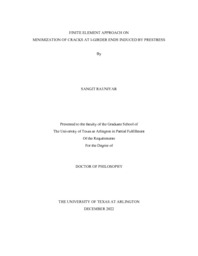
ATTENTION: The works hosted here are being migrated to a new repository that will consolidate resources, improve discoverability, and better show UTA's research impact on the global community. We will update authors as the migration progresses. Please see MavMatrix for more information.
Show simple item record
| dc.contributor.advisor | Abolmaali, Ali | |
| dc.contributor.advisor | Jalali, Himan Hojat | |
| dc.creator | Rauniyar, Sangit | |
| dc.date.accessioned | 2023-01-26T16:14:01Z | |
| dc.date.available | 2023-01-26T16:14:01Z | |
| dc.date.created | 2022-12 | |
| dc.date.issued | 2022-11-28 | |
| dc.date.submitted | December 2022 | |
| dc.identifier.uri | http://hdl.handle.net/10106/31014 | |
| dc.description.abstract | Prestressed I-girders are one of the very commonly and widely used girders for bridges. It is produced at precast plant and transported to bridge site. To produce a prestressed I-girder,
strands are first pulled and concrete is poured in I-girder’s formwork. Once the concrete reaches a desired strength, strands are released which induce prestress in I-girder. There are mainly two types of design for I-girders-one that requires debonding of strands at the end of I-girders and another that requires harping of strands at the end of I-girders. The debonding and harping of strands are done to reduce tension at the top flange of I-girder as required strength for moment at the end of I-girders are much less than at mid-span of I-girders. The requirement of de-bonding criteria limits its utilization for all design cases as different bridges have different span length and girder depth requirements. This study focuses on I-girder with harped strand case as it is very commonly used and cracks at the girder ends are commonly observed. Reinforcement bars are used at the ends of I-girders to limit the width of the cracks. However, sometimes the cracks are wider and can result in rejection of the I-girder by quality control personnel. When wider cracks are observed, spacing of vertical reinforcements are reduced to reduce crack width, but
the spacing can be reduced only to certain extent due to congestion of the reinforcement. Therefore, the cracks width cannot be minimized to desired level in all cases by reducing the
spacing of vertical bars. Moreover, a corrective action is required if wider cracks are observed on a repetitive basis that exceeds the limit provided on fabrication notes. The wider cracks can allow moisture to reach the reinforcements and strands easily resulting in corrosion, which can
reduce the durability of I-girders. Previous studies have shown that increasing area of reinforcement bars will not further help in significantly minimizing the crack width. In this
study, a non-linear finite element modeling (FEM) approach was used to show that using a prestressing strand in I-girder web in vertical direction at the girder ends can significantly
minimize the cracks. The FEM modeling assumptions were validated by comparing with experimental data available in the literature. In addition, sensitivity analysis was performed and
non-linear regression equation was developed. | |
| dc.format.mimetype | application/pdf | |
| dc.language.iso | en_US | |
| dc.subject | I-Girder Ends | |
| dc.subject | Cracks | |
| dc.subject | Prestress | |
| dc.subject | FEM | |
| dc.title | FINITE ELEMENT APPROACH ON MINIMIZATION OF CRACKS AT I-GIRDER ENDS INDUCED BY PRESTRESS | |
| dc.type | Thesis | |
| dc.contributor.committeeMember | Karbhari, Vistasp | |
| dc.contributor.committeeMember | Chao, Shih-Ho | |
| dc.contributor.committeeMember | Bell, Bradley | |
| dc.date.updated | 2023-01-26T16:14:01Z | |
| thesis.degree.department | Civil Engineering | |
| thesis.degree.grantor | The University of Texas at Arlington | |
| thesis.degree.level | Doctoral | |
| thesis.degree.name | Doctor of Philosophy in Civil Engineering | |
| dc.type.material | text | |
| dc.creator.orcid | 0000-0002-0333-6488 | |
Files in this item
- Name:
- RAUNIYAR-DISSERTATION-2022.pdf
- Size:
- 9.482Mb
- Format:
- PDF
This item appears in the following Collection(s)
Show simple item record


